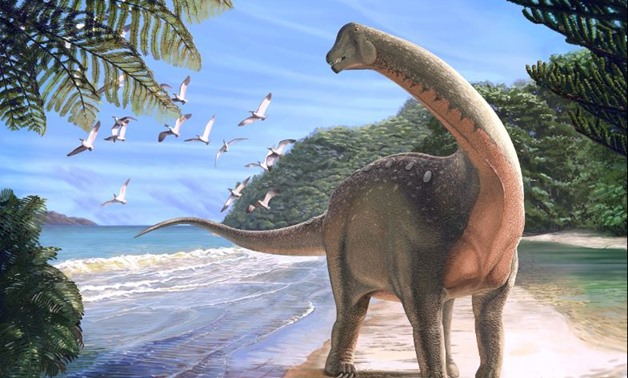
An artist's reconstruction of the Mansourasaurus shahinae - Carnegie Museum of Natural History / Andrew McAfee
CAIRO – 18 February 2018: A city on the Red Sea is rich in Calcium phosphate, which is formed mainly from bones, hence new dinosaur fossils may be discovered shortly, the Head of the Nature Protection Sector in the Ministry of Agriculture Ahmed Salama stated on Sunday.
Salama affirmed his perspective, saying that the same form of phosphate was found in El-Wahat el-Bahariya (Western Desert of Egypt), before discovering the dinosaur fossils which date back to about 95 million years ago.
Dinosaur remains are usually found in the areas of marine and river sediments, Salama said, adding that these types of sediments were found at the Dakhla Oasis in central Egypt and El-Wahat el-Bahariya before discovering the dinosaur fossils there.
Salama asserted the possibility of finding the remnants of dinosaurs, stressing that so far the mystery of dinosaur extinction has not yet been solved.
In the last few days, a research team at the Mansoura University Vertebrate Paleontology center (MUVP) uncovered a new extremely rare dinosaur species, attracting the world’s attention to Egypt’s fossil record.
In cooperation with Ohio University, the Leakey Foundation, the National Geographic Society, and the National Science Foundation, the research team has conducted intensive studies on the fossil to discover its species.
 Main Caption: The all-Egyptian field team from the Mansoura University Vertebrate Paleontology initiative that found and collected the new titanosaurian dinosaur Mansourasaurus shahinae with the plaster ‘jackets’ containing the fossil skeleton at the disc
Main Caption: The all-Egyptian field team from the Mansoura University Vertebrate Paleontology initiative that found and collected the new titanosaurian dinosaur Mansourasaurus shahinae with the plaster ‘jackets’ containing the fossil skeleton at the disc
They found out that the species, named Mansourasaurus shahinae, belongs to a dinosaur group called the Titanosaurs that mostly lived in southern Europe and eastern Asia. It dates back to between 100 and 66 million years ago during the late cretaceous era in Egypt, according to a study published on January 29, 2018, in the renowned scientific journal “Nature”.
The team was comprised of the head of the center Hesham Sallam, founder of MUVP and associate professor at the department of Geology of Mansoura University, Sanaa el-Sayed, demonstrator at the Faculty of Science of Mansoura University and a trainee at the center, Mai el-Amir, MA student at Mansoura University, Iman el-Dawoudi, demonstrator at Mansoura University and Sara Saber, demonstrator at Assiut University and Farahat Ibrahim, MA student at Mansoura University.
During the cretaceous era, Egypt’s Western Desert was one of the most fertile areas in the region and attracted many organisms including dinosaurs.
After doing extensive studies, the team discovered a link between Mansourasaurus and a European dinosaur, indicating the possibility of the presence of a bridge that linked Africa and Europe millions of years ago.
 Skeletal reconstruction of the new titanosaurian dinosaur Mansourasaurus found in Egypt. Bones shown in color are those that are preserved in the original fossil; other bones are based on those of closely related dinosaurs - Carnegie Museum of Natural History / Andrew McAfee
Skeletal reconstruction of the new titanosaurian dinosaur Mansourasaurus found in Egypt. Bones shown in color are those that are preserved in the original fossil; other bones are based on those of closely related dinosaurs - Carnegie Museum of Natural History / Andrew McAfee
This is one of the reasons as to why this discovery is particularly significant; a land bridge between Europe and Africa is plausible because scientists believe that there was no land link from northern Asia and Europe to the southern bloc which modern day Africa was a part of.
“[It] offer[s] the most robust support to date of non-marine vertebrate dispersal between Africa and Europe,” according to an article published on January 29 by the Nature Ecology and Evolution website.


Comments
Leave a Comment